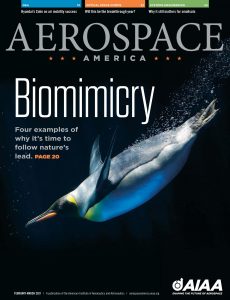
Aerospace America – February-March 2021
English | 71 pages | pdf | 7.4 MB
Welcome at Aerospace America magazine February-March 2021 issue
Our cover story about biomimicry has me looking at human history and biology with fresh eyes. Biologically inspired innovations in aerospace, it turns out, don’t necessarily have to come from things that fl y, and those innovations aren’t always easily traceable to nature. In fact, the term “biomimicry” and an alternative term, “biomimetics,” though handy for headlines, could leave an incorrect impression about the modern incarnation of this ancient aspiration of matching the performance of nature.
Engineers and scientists in this fi eld more often than not take inspiration from nature rather than attempt to replicate it. A palm tree bends in the wind to survive a hurricane, so why not make aerospace structures that are similarly strong and fl exible? A beetle, with no conscious thought, can match its hue to its surroundings, so why can’t an aircraft automatically turn sand-colored over the desert and lush green over the jungle? An emperor penguin doesn’t know it, but its feathers release bubbles into the surrounding water to reduce drag, so why can’t an aircraft manipulate the medium through which it fl ies? A harbor seal’s whiskers evolved to minimize drag in the water, so could there be a lesson in that for turbine blades?
It’s tempting to attribute this growing interest in biomimicry entirely to adjacent revolutions in materials, artifi cial intelligence, machine learning and quantum computing, some of which also have biological roots. No doubt, breakthroughs in these areas could, at last, empower humanity to create machines approaching the sophistication of millions of years of evolution. But that can’t happen without the right culture. As our cover story signals, scientists and engineers are no longer disregarded as quirky because they see lessons in nature and want to spend money trying to capitalize on them. Minds are open, and inspirations are welcomed more so than in the past.
To see the power of culture, consider that the human mind has been about the same for 200,000 years, and yet humanity could not fl y for the fi rst 199,882 of those years. It’s only the relatively recent embrace of a scientifi c culture that fully explains what took so long. So, if we can keep the right culture in place, we can capitalize on nature and achieve so much more.
Ben Iannotta, editor-in-chief, beni@aiaa.org
Download from:
NitroFlare